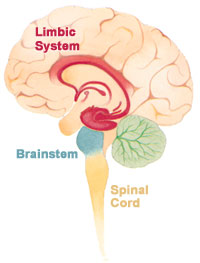
Opiates resemble natural chemicals that have binding sites in the brain and the body called opiate receptors. Scientists have identified three types of opiate receptors: mu, delta, and kappa (named after letters in the Greek alphabet). Each of these receptors is involved in different functions. For example, mu receptors are responsible for the pleasurable effects of opiates, and their pain-relieving properties.
Opiates act on many places in the brain and nervous system, including:

- the limbic system, which controls emotions. Acting here, opiates can produce feelings of pleasure, relaxation, and contentment.
- the brainstem, which controls things your body does automatically, like breathing. Opiates can act on the brainstem to slow breathing, stop coughing, and lessen feelings of pain.
- the spinal cord, which transmits sensations from the body. Opiates also act here to decrease feelings of pain, even following serious injuries.
Whether it is a medication like Vicodin or a street drug like heroin, the effects of opiates (and many other drugs) depend on how much you take and how you take it. If opiates are swallowed as pills, they take longer to reach the brain. If they are injected, they act faster and can produce a quick, intense feeling of pleasure followed by a sense of well-being and a calm drowsiness.




